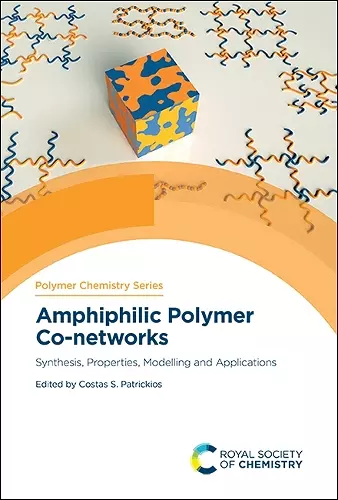Amphiphilic Polymer Co-networks
Synthesis, Properties, Modelling and Applications
Format:Hardback
Publisher:Royal Society of Chemistry
Published:30th Apr '20
Currently unavailable, and unfortunately no date known when it will be back

Amphiphilic polymer co-networks (APCNs) are a type of polymeric hydrogel, their hydrophobic polymer segments and hydrophilic components produce less aqueous swelling, giving better mechanical properties than conventional hydrogels. This new class of polymers is attracting increasing attention, resulting in further basic research on the system, as well as new applications.
This book focuses on new developments in the field of APCNs, and is organised in four sections: synthesis, properties, applications and modelling. Co-network architectures included in the book chapters are mainly those deriving from hydrophobic macro-cross-linkers, representing the classical approach; however, more modern designs are also presented. Properties of interest discussed include aqueous swelling, thermophysical and mechanical properties, self-assembly, electrical actuation, and protein adsorption. Applications described in the book chapters include the use of co-networks as soft contact lenses, scaffolds for drug delivery and tissue engineering, matrices for heterogeneous biocatalysis, and membranes of controllable permeability. Finally, an important theory chapter on the modelling of the self-assembly of APCNs is also included.
The book is suitable for graduate students and researchers interested in hydrogels, polymer networks, polymer chemistry, block copolymers, self-assembly and nanomaterials, as well as their applications in contact lenses, drug delivery, tissue engineering, membranes and biocatalysis.
I recommend this book to professionals working in polymers and materials science and engineering, but also to advanced undergraduates and graduate students in chemistry, chemical, biological or materials engineering who are looking for a firm grounding in polymer science.
* Personal Review *The book [Amphiphilic Polymer Co-networks] is the first book integrating the most relevant information on the topic and is highly recommended for scientists and engineers interested in the development of new soft materials.
* 10.1002/anie.202006776 *Overall, the book succeeds in highlighting many areas of interest and challenges in amphiphilic polymer co-networks, and it serves as a good starting point to chemists and chemical engineers interested in this field.
* Personal ReviISBN: 9781788013703
Dimensions: unknown
Weight: 760g
363 pages